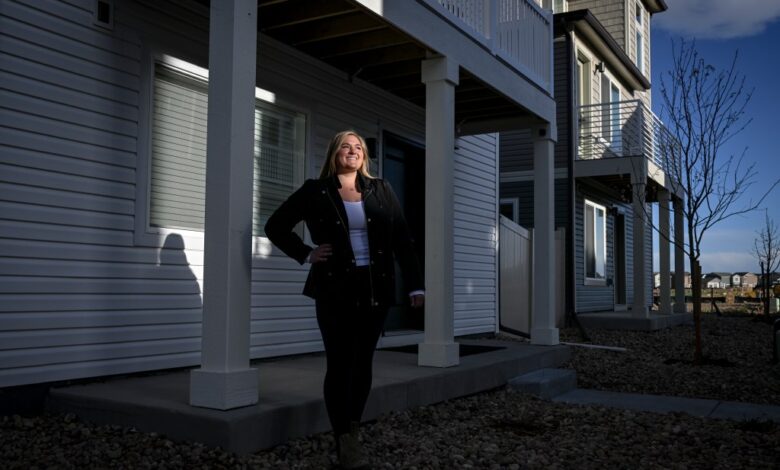First-time buyers heading east, north of metro Denver to find housing

Kelly Morgan’s Journey from Rental to Homeownership
Kelly Morgan, 27, hails from Arizona and carried a valuable piece of advice from her parents when she relocated to Colorado. Her parents instilled in her the importance of purchasing a home at a young age, much like they did in their mid-20s.
Initially, Morgan was skeptical about the feasibility of buying a home at her age. However, after meeting with a lender and getting pre-qualified, she realized that it was within reach. Despite her qualifications, the Denver housing market presented challenges in finding a suitable home within her $300,000 to $400,000 budget.
Condos, a traditional entry point into homeownership, posed additional hurdles with high association fees and maintenance issues. Understanding the implications of deferred maintenance, Morgan opted for a new two-story home in Bennett at Muegge Farms developed by Oakwood Homes.
While the median home price in Denver stood at $660,000, Morgan secured her new home for $375,000, offering her a chance to build equity. The trade-off for this affordable option was a slightly longer commute from Bennett to Brighton, providing a quieter and more serene living environment compared to the bustling city.
In a market where first-time homebuyers are becoming increasingly rare, Morgan’s purchase at 27 years old stands out as an outlier. The National Association of Realtors reported that first-time buyers accounted for only 24% of the market last year, a significant decline from 44% in 1981.
The shift away from entry-level housing towards move-up and luxury markets has created a shortage of affordable options for first-time buyers. Rising mortgage rates, soaring home prices, and limited inventory have further compounded the challenges for prospective homeowners.
Despite the allure of renting due to short-term cost savings, homeownership remains a key driver of wealth accumulation. The disparity in net worth between renters and homeowners underscores the long-term financial benefits of owning a home.
Addressing Affordability Challenges
Recognizing the need for more affordable housing options, builders like Oakwood Homes have focused on developing starter homes in outlying areas like Bennett. By offering compact homes with efficient floor plans at lower price points, these builders aim to make homeownership accessible to a broader demographic.
Utilizing innovative construction methods, such as prefabrication and modular building, Oakwood Homes can streamline costs and enhance quality control. Additionally, builders can provide financial incentives like mortgage rate buy-downs to ease the burden of monthly payments for first-time buyers.
While some criticize the trend of building homes in exurban areas, builders like Oakwood Homes view it as a strategic approach to promoting affordability and expanding housing options across the metro area. By catering to the needs of first-time buyers, these builders are bridging the gap in the housing market.
Other developers, like Landsea Homes, have also embraced the outer perimeter strategy to offer more affordable housing solutions in areas like Brighton and Johnstown. By diversifying their offerings and exploring infill opportunities, builders are working towards creating a more inclusive housing landscape.
The push towards exurban living has been further fueled by the rise of remote work, allowing individuals to pursue homeownership in more affordable regions while maintaining connectivity to urban centers. While exurban living presents its challenges, such as longer commutes and limited amenities, it offers a pathway to homeownership for those priced out of city markets.
As Colorado continues to grapple with housing affordability issues, legislative measures like the Multifamily Construction Incentive Program aim to incentivize builders to construct more condos and address the shortage of affordable housing options. By breaking down barriers to condo development, policymakers hope to unlock new opportunities for aspiring homeowners.

Considering the Pros and Cons
While exurban living offers a pathway to homeownership for many, prospective buyers must weigh the pros and cons of living in outlying areas. Lower construction quality, longer commutes, and limited amenities are common challenges faced by exurban residents.
It’s essential for buyers to conduct thorough research and evaluate their tolerance for the trade-offs associated with exurban living. While affordability may be a driving factor, buyers must also consider the long-term implications of their decision and ensure it aligns with their lifestyle preferences.
Ultimately, the shift towards exurban living reflects the evolving dynamics of the housing market and the quest for affordable homeownership. By expanding housing options and addressing affordability challenges, builders are paving the way for a more inclusive and diverse housing landscape.
For more real estate and business news, subscribe to our weekly newsletter, On the Block.





